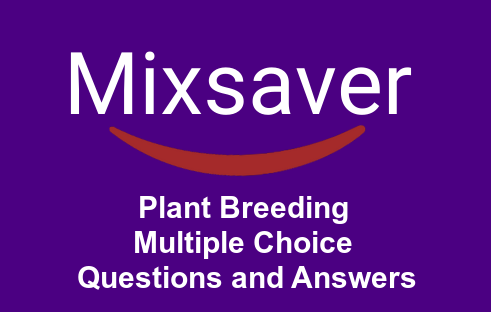Cell Cycle, Cell Division & Cell Signalling MCQs
1. The role of mitosis is not merely to divide a cell into two daughter cells but to ensure genetic continuity from one cell generation to the another cell generation . The mechanism ensuring genetic continuity is
( a ) the formation of cells with new chromosomes
( b ) the formation of two daughter cells
( c ) the formation of two cells with identical DNA
( d ) having the chromosome number between the two new cells
Ans. c
2. If 2n = 8 , what shall be the number of chromatids in each daughter cell after meiosis – I ?
( a ) Four
( b ) Sixteen
( c ) Two
( d ) Eight
Ans. a
3. Synaptonemal complex is a structure of
( a ) cytokinesis
( b ) chromosomal disfunction
( c ) terminalisation
( d ) chromosomal pairing
Ans. d
4. Chromosomal puffs ( Balbiani’s ring ) are the active site for
( a ) assembly of purine and pyrimidine bases for DNA replication
( b ) steroidogenesis
( c ) lipogenesis
( d ) synthesis of RNA and protein
Ans. d
5. Polytene chromosomes were first discovered in
( a ) Phlebotomus
( b ) Glossina
( c ) Drosophila
( d ) Chironomus
Ans. c
6. Identify the false statement .
( a ) Pairing of paternal and maternal chromosomes during zygotene is called synapse
( b ) Chiasmata are the site for crossing over of genetic material
( c ) Terminalisation occurs during diplotene
( d ) Prophase – l is the most complicated and longest stage of meiosis
Ans. c
7. Which significant changes occur ( s ) during the diakinesis phase of meiotic prophase – I ?
( a ) Breakdown of nucleolus
( b ) Fragmentation of nuclear membrane
( c ) Terminalisation
( d ) All of the above
Ans. d
8. During cell division , the splitted chromosomes move towards opposite poles due to
( a ) microtubules
( b ) centrioles
( c ) cytoplasmic streaming
( d ) phragmoplast
Ans. a
9. Mitosis in adult animal does not occur in
( a ) skin
( b ) bone marrow
( c ) testes
( d ) nails
Ans. d
10. In which stage of meiotic prophase – I , chromosomes become thread – like and visible ?
( a ) Diakinesis
( b ) Leptotene
( c ) Zygotene
( d ) Pachytene
Ans. b
Cell cycle and Cell division mcq for neet pdf
11. During which phase in somatic cell division , replication of the chromosome takes place ?
( a ) Interphase
( b ) Middle prophase
( c ) Early prophase
( d ) Late prophase
Ans. a
12. At prophase of mitosis , a eukaryote chromosome consists of two chromatids . What is the structure of a single chromatid ?
( a ) One molecule of single – stranded DNA coiled around protein molecules
( b ) Two molecules of single – stranded DNA each coiled around protein molecules
( c ) One double helix of DNA coiled around protein molecules
( d ) Two double helix of DNA each coiled around protein molecules
Ans. c
13. True statement for mitosis is
( a ) the cell formed by it form diverse functions , le show division of labour
( b ) two cells formed as a result of this division are identical in all respects
( c ) cell formed by it have half the number of chromosomes than that of parent cell
( d ) cell formed as a result of mitosis have different genetic characters
Ans. b
14. The meiotic division which occurs in zygote is called
( a ) sporic
( b ) initial
( c ) intermediate
( d ) zygotic
Ans. d
15. How would the daughter cell at the end of mitosis and tokinesis compare with their parent cell when it was in G1 of the cell cycle ?
( a ) The daughter cells have half the amount of cytoplasm and half the amount of DNA
( b ) The daughter cells have half the number of chromosomes half the amount of DNA
( c ) The daughter cells have the same number of chromosomes and half the amount of DNA
( d ) The daughter cells have the same number of chromosomes and same amount of DNA
Ans. c
16. Genetic homogeneity and exact similarity between chromosomes of various cells within the same type of tissue of a plant is largely due to
( a ) cytokinesis
( b ) mitosis
( c ) meiosis
( d ) fertilisation
Ans. b
17. Which type of chromosomes segregate when a cell undergoes meiosis?
(a) Homologous chromosomes
(b) Non-homologous chromosomes
(c) Both (a) and (b)
(d) Centric and acentric chromosomes
Ans. a
Cell cycle and Cell division neet questions pdf
18. Cellular structures which always disappear during mitosis are
(a) plastids and mitochondria
(b) nuclear envelope and nucleolus
(c) cell wall and plasmalemma
(d) cell wall and nucleolus
Ans. b
19. Phragmoplast is related to the
(a) division of nucleolus
(b) cell elongation
(c) cytokinesis
(d) assemblage of chromosomes at metaphase
Ans. c
20. Complete process of meiosis involves
(a) one cytoplasmic division with only one chromosome duplication
(b) two cytoplasmic divisions with one duplication of chromosome
(c) two cytoplasmic divisions with two duplication of chromosome
(d) one cytoplasmic division with two duplication of chromosome
Ans. b
21. Meiotic divisions in an angiospermic plant can be observed by examining the cells of
(a) the apical meristem of the stem
(b) the apical dividing cells in the root tip
(c) cells of the vascular cambium when they are dividing
(d) pollen mother cells when they are undergoing the divisions of another
Ans. d
22. Distribution of genetic material occurs from generation to generation and permits great genetic diversity by frequent reorganisation of genetic complement. This occurs during
(a) mitosis
(b) meiosis
(c) organogenesis
(d) metamorphosis
Ans. b
24. Centrioles plays an important role in the formation of
(a) brush border of a cell
(b) synthesis of actin and myosin protein
(c) transduction of signals from one cell to other
(d) spindle apparatus of a dividing cell
Ans. d
25. Dyad acts as a pair of
(a) non-sister chromatids
(b) homologous chromosomes
(c) non-homologous chromosomes
(d) sister chromatids
Ans. d
26. The nuclear membrane disappears at which stage of mitosis
(a) telophase
(b) prophase
(c) metaphase
(d) anaphase
Ans. b
27. The shortest phase of the cell cycle is
(a) G2
(b) S
(c) G
(d) M
Ans. d
cell division neet mcq pdf | cell cycle multiple choice questions | mcq on cell cycle regulation
28. A disc-shaped structure found on the sides of centromere of chromosome is
(a) kinetochore
(b) telomere
(c) chromocentre
(d) centronema
Ans. a
29. The major component of the synaptonemal complex is
(a) protein
(b) lipid
(c) fat
(d) nucleic acid
Ans. a
30. During pachytene stage of meiosis, the chromosomes appears
(a) four-stranded
(b) single-stranded
(c) double-stranded
(d) eight-stranded
Ans. a
31. Formation of a chromatid takes place in
(a) S-phase
(b) Metaphase
(c) G1-phase
(d) G2-phase
Ans. a
32. When cells respond to an extracellular signal, they often converts the information from one form to the another. The process is
(a) signal transduction
(b) signal transformation
(c) signal amplification
(d) signal interference
Ans. a
33. Steroid hormones, estrogen and testosterone are most likely to bind to
(a) enzyme linked membrane receptor
(b) cytoplasmic receptors
(c) membrane ion channel
(d) G-protein linked membrane receptor
Ans. b
cell cycle and cell division class 11 neet notes
34. Which signal binds to receptors and stimulates the near by cells?
(a) Exocrine
(b) Endocrine
(c) Paracrine
(d) Autocrine
Ans. c
35. When could the cell normally proceed to mitosis withoun intruption?
(a) It has entered the G2-phase
(b) It has entered the S-phase
(c) Anytime during the cell division
(d) None of the above
Ans. b
36. How many mitotic divisions are required to produce 128 cells from a single cell?
(a) 7
(b) 8
(c) 16
(d) 32
Ans. a
37. Hypnotic meiosis occurs in
(a) Puccinia
(b) Chlamydomonas
(c) Pteris
(d) Puccinia
Ans. b
38. During metaphase mitosis chromosomes
(a) undergoes coiling
(b) moves towards the poles
(c) line up at the equator
(d) break and disintegrate
Ans. c
cell cycle and cell division class 11 ncert pdf | question bank on cell cycle
39. If a cell divides in every one mintute. And this rate of division it can fill a 100 mL of beaker in one hour. Calculate how much time does it take to fill a 50 ml. beaker?
(a) 30 min
(b) 60 min
(c) 59 min
(d) 65 min
Ans. c
40. Which aspect of mitosis is affected by Colchicine in inducing polypeptide?
(a) Spindle formation
(b) Cell plate formation
(c) Chromosome doubling
(d) DNA duplication
Ans. a
41. Cell cycle of germinal cell has
(a) 2 successive mitotic divisions
(b) 2 successive reductive divisions
(c) very short prophase in first division
(d) on reduction division followed by one mitotic division
Ans. d
42. During cell division, sometimes there will be failure of separation of sister chromatids. This cucuta is called
(a) coincidence
(b) fusion
(c) non-disjunction
(d) interference
Ans. c
43. During synapsis, the number of thread (chromoemata) in each chromosome is
(a) 2
(b) 4
(c) 8
(d) many
Ans. a
44. Synapis is a characteristic of
(a) leptotene
(b) diplotene
(c) zygotene
(d) pachytene
Ans. c
45. Cell division of mitosis in a normal process in a living cell but sudden and abnormal mitosis in an organ will sometimes result in
(a) cancer
(b) new organ
(c) zygote
(d) gastrula
Ans. a
46. Estimate the number of generations of mitotic divisions that must occur in a cell of root tip to form 256 cells
(a) 8
(b) 32
(c) 64
(d) 128
Ans. a
47. DNA content gets doubled during which phase of cell cycle?
(a) G1-phase
(b) G2-phase
(c) Metaphase
(d) S phase
Ans. d
48. Which of the following in unique to mitosis and is not a part of meiosis?
(a) Homologous chromosomes pair and forms bivalents
(b) Chromatids are separated during anaphase
(c) Homologous chromosomes behaves independently
(d) Homologous chromosomes crossover
Ans. c
49. Arrange the following events of meiosis in the correct sequence. I. Terminalisation II. Crossing over III. Synapsis IV. Disjunction of genomes
(a) II, I, IV, II
(b) III, II, I, IV
(c) IV, II, I
(d) I, IV, II, I
Ans. b
50. In paracrine signalling, the signalling molecule affects only
(a) target cell olose to the cell from which it was secreted
(b) target cells distant from its site of synthesis in cells of an endocrine organ
(c) Both (a) and (b)
(d) None of the above
Ans. a
51. Identify the one which is not a type of a signalling molecule.
(a) Insulin
(b) Thyroxin
(c) Testosterone
(d) Acetylate cycles
Ans. d
52. SH, domain specifically binds to
(a) Ca 2+
(b) GDP
(c) phosphorylated serine residue
(d) phosphorylated tyrosine residue
Ans. d
53. When a . reaches its . ., there is a specific means of recurring it and acting on the message. This task is the responsibility of a specialised proteins called ………
(a) signalling molecule, receptor, G-protein
(b) signalling molecule, target cell, G-proteins
(c) signalling molecule, target cell, receptors
(d) kinase, receptor, protease
Ans. c
54. Which of the following comes under the category of cell surface receptor?
(a) Enzyme linked receptors
(b) G-protein linked receptors
(c) lon-channel linked receptors
(d) All of the above
Ans. d
55. In terms of cell communication, what do the bacterial pathogens such as cholera and anthrax have in common?
(a) they prevent the production of key signalling molecules
(b) they alter the chemical structure of key signalling molecules
(c) they destroy the receptors for key signalling molecules
(d) they block the normal functioning of signal transduction mechanisms
Ans. d





